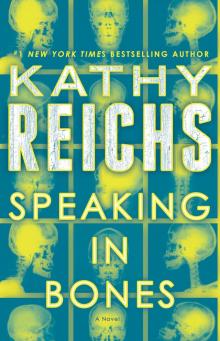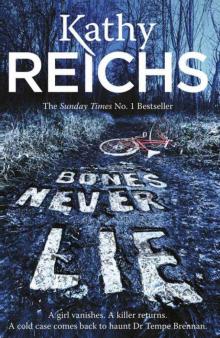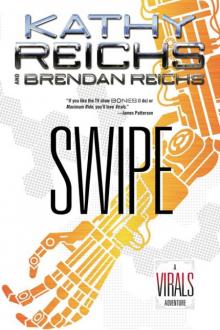- Home
- Kathy Reichs
Speaking in Bones
Speaking in Bones Read online
Speaking in Bones is a work of fiction. Names, characters, places, and incidents are the product of the author’s imagination or are used fictitiously. Any resemblance to actual events, locales, or persons, living or dead, is entirely coincidental.
Copyright © 2015 by Temperance Brennan, L.P.
All rights reserved.
Published in the United States by Bantam Books, an imprint of Random House, a division of Penguin Random House LLC, New York.
BANTAM BOOKS and the HOUSE colophon are registered trademarks of Penguin Random House LLC.
Library of Congress Cataloging-in-Publication Data
Reichs, Kathy.
Speaking in bones: a novel / Kathy Reichs.
pages cm
ISBN 978-0-345-54404-9
eBook ISBN 978-0-345-54405-6
1. Brennan, Temperance (Fictitious character)—Fiction. 2. Women forensic anthropologists—Fiction. I. Title.
PS3568.E476345S64 2015
813'.54—dc23 2015012541
eBook ISBN 9780345544056
randomhousebooks.com
eBook design adapted from printed book design by Carole Lowenstein
Cover design: Carlos Beltrán
v4.1
ep
Contents
Cover
Title Page
Copyright
Chapter 1
Chapter 2
Chapter 3
Chapter 4
Chapter 5
Chapter 6
Chapter 7
Chapter 8
Chapter 9
Chapter 10
Chapter 11
Chapter 12
Chapter 13
Chapter 14
Chapter 15
Chapter 16
Chapter 17
Chapter 18
Chapter 19
Chapter 20
Chapter 21
Chapter 22
Chapter 23
Chapter 24
Chapter 25
Chapter 26
Chapter 27
Chapter 28
Chapter 29
Chapter 30
Chapter 31
Chapter 32
Chapter 33
Chapter 34
Chapter 35
Chapter 36
Chapter 37
Dedication
Acknowledgments
By Kathy Reichs
About the Author
“I’m unbound now. My wrists and ankles burn from the straps. My ribs are bruised and there’s a lump behind my ear. I don’t remember hitting my head. I’m lying very still because my whole body aches. Like I’ve been in a wreck. Like the time I crashed my bike. Why doesn’t my family save me? Is no one missing me? I have only my family. No friends. It was just too hard. I’m all alone. So alone. How long have I been here? Where is here? The whole world is slipping away. Everything. Everyone. Am I awake or asleep? Am I dreaming or is this real? Is it day or night?
“When they return they will hurt me again. Why? Why is this happening to me? I can’t hear a sound. No. That’s not true. I can hear my heart beating. Blood working inside my ears. I taste something bitter. Probably vomit stuck in my teeth. I smell cement. My own sweat. My dirty hair. I hate when my hair isn’t washed. I’m gonna open my eyes now. Got one. The other’s crusted shut. Can’t see much. It’s all blurry, like I’m looking up from way down underwater.
“I hate the waiting. That’s when the pictures take over my brain. Not sure if they’re memories or hallucinations. I see him. Always in black, his face crazy red and beaded with sweat. I avoid his eyes. Keep looking at his shoes. Shiny shoes. The candle flame’s a little yellow worm dancing on the leather. He stands over me, all big and nasty. Thrusts his horrid, smelly face close to mine. I feel his icky breath on my skin. He gets mad and yanks me by the hair. His veins go all bulgy. He screams and his words sound like they’re coming from another planet. Or like I’ve left my body and I’m listening from far away. I see his hand coming at me, clutching the thing so tight it quivers. I know I’m shaking but I’m numb. Or am I dead?
“No! Not now! Don’t let it happen now!
“My hands are going all cold and tingly. I shouldn’t be talking about him. I shouldn’t have said he was horrid.
“Yes. They’re coming.
“Why is this happening to me? What did I do? I’ve always tried to be good. Tried to do what Mama said. Don’t let them kill me! Mama, please don’t let them kill me!
“My mind is going all fuzzy. I have to stop talking.”
Silence, then the click-creak of a door opening. Closing.
Footsteps, unhurried, firm on the floor.
“Take your place.”
“No!”
“Don’t resist me.”
“Leave me alone!”
The cadence of frantic breathing.
The thunk of a blow.
“Please don’t kill me.”
“Do as I say.”
Sobbing.
Sound as if dragging.
Moaning. Rhythmic.
“Are you in my hands?”
“Filthy bitch!” Louder, deeper.
A soft rasp.
The tic of metal snapping into place.
“You will die, slut!”
“Will you answer me now?”
“Whore!”
The drumming of agitated fingers. Scratching.
“Give me what I need!”
Pfff! The violent hurling of spit.
“You will not answer?”
Moaning.
“This has only begun.”
Click-creak. The furious slam of a door.
Absolute stillness. Soft sobbing.
“Please don’t kill me.
“Please don’t kill me.
“Please.
“Kill me.”
The woman’s knuckles bulged pale under skin that was cracked and chapped. Using one knobby finger, she depressed a button on the object in the Ziploc.
The room went still.
I sat motionless, the hairs on my neck lifted like grass in a breeze.
The woman’s eyes stayed hard on mine. They were green flecked with yellow, and made me think of a cat. A cat that could bide, then pounce with deadly accuracy.
I let the silence stretch. Partly to calm my own nerves. Mostly to encourage the woman to explain the purpose of her visit. I had flight reservations in just a few hours. So much to do before heading to the airport. To Montreal and Ryan. I didn’t need this. But I had to know the meaning of the terrible sounds I’d just heard.
The woman remained angled forward in her chair. Tense. Expectant. She was tall, at least six feet, and wore boots, jeans, and a denim shirt with the cuffs rolled up her lower arms. Her hair was dyed the color of the clay at Roland Garros. She’d yanked it into a bun high on her head.
My eyes broke free from the cat-gaze and drifted to the wall at the woman’s back. To a framed certificate declaring Temperance Brennan a diplomate of the American Board of Forensic Anthropology. D-ABFA. The exam had been a bitch.
I was alone with my visitor in the 120 square feet allocated to the Mecklenburg County Medical Examiner’s consulting forensic anthropologist. I’d left the door open. Not sure why. Usually I close it. Something about the woman made me uneasy.
Familiar workplace sounds drifted in from the corridor. A ringing phone. A cooler door whooshing open then clicking shut. A rubber-wheeled gurney rolling toward an autopsy suite.
“I’m sorry.” I was pleased that my voice sounded calm. “The receptionist provided your name but I’ve misplaced my note.”
“Strike. Hazel Strike.”
That caused a little ping in my brain. What?
“Folks call me Lucky.
”
I said nothing.
“But I never rely on luck. I work hard at what I do.” Though I guessed Strike’s age at somewhere north of sixty, her voice was still twentysomething strong. The accent suggested she was probably local.
“And what is it you do, Ms. Strike?”
“Mrs. My husband passed six years back.”
“I’m sorry.”
“He knew the risk, chose to smoke.” Slight lift of one shoulder. “You pay the price.”
“What is it you do?” I repeated, wanting to draw Strike back on point.
“Send the dead home.”
“I’m afraid I don’t understand.”
“I match bodies to people gone missing.”
“That is the task of law enforcement in conjunction with coroners and medical examiners,” I said.
“And you pros nail it every time.”
I bit back another priggish response. Strike had a point. Stats I’d read put the number of missing persons in the United States at around 90,000 at any given time, the number of unidentified remains from the past fifty years at more than 40,000. The last count I saw placed the North Carolina UID total at 115.
“How can I help you, Mrs. Strike?”
“Lucky.”
“Lucky.”
Strike placed the Ziploc beside a bright yellow case file on my blotter. In it was a gray plastic rectangle, roughly one inch wide, two inches long, and a half inch thick. A metal ring at one end suggested dual functions as a recorder and a key chain. A loop of faded denim suggested the device had once hung from the waistband of a pair of jeans.
“Impressive little gizmo,” Strike said. “Voice activated. Two-gigabyte internal flash memory. Sells for less than a hundred bucks.”
The yellow folder called to me. Accusingly. Two months earlier a man had died in his recliner, TV remote clutched in one hand. The previous weekend his mummified corpse had been found by a very unhappy landlord. I needed to wrap this up and get back to my analysis. Then home to packing and the delivery of my cat to the neighbor.
But those voices. My pulse was still struggling to return to normal. I waited.
“The recording lasts almost twenty-three minutes. But the five you heard is plenty to get the drift.” Strike gave a tight shake of her head. Which reangled the bun to an off-center tilt. “Scares the patootie out of you, don’t it?”
“The audio is disturbing.” An understatement.
“Ya think?”
“Perhaps you should play it for the police.”
“I’m playing it for you, Doc.”
“I believe I heard three voices?” Curiosity was overcoming my reticence to engage. And apprehension.
“That’s my take. Two men and the girl.”
“What was happening?”
“Don’t know.”
“Who was speaking?”
“Only got a theory on one.”
“And that is?”
“Can we back up a bit?”
I brushed my eyes past my watch. Not as discreetly as I thought.
“Unless you’re not ‘tasked’ with sticking names on the dead.” Strike hooked sarcastic finger quotes around the term I’d used moments earlier.
I leaned back and assumed my listening face.
“What do you know about websleuthing?”
So that was it. I vowed to keep my tone patient, but my answers short.
“Websleuths are amateurs competing online to solve cold cases.” Wannabe forensic scientists and cops. Overzealous viewers of NCIS, Cold Case, CSI, and Bones. I didn’t add that.
Strike’s brows drew together over her nose. They were dark and looked wrong with the pale skin and fake carrot hair. She studied me a very long time before responding.
“Most people die, they get a funeral, a wake, a memorial service. There are eulogies, an obit in the paper. Some get holy cards showing their faces with angels or saints or whatnot. You’re really hot stuff, maybe there’s a school or a bridge named in your honor. That’s what’s supposed to happen. That’s how we deal with death. By recognizing a person’s achievements in life.
“But what happens when someone just disappears? Poof.” Strike curled then exploded her fingers. “A man leaves for work and vanishes? A woman boards a bus and never gets off?”
I started to speak but Strike rolled on.
“And what happens when a body turns up lacking ID? On a roadside, in a pond, bundled in a carpet and stashed in a shed?”
“As I’ve stated, that is the job of police and medical examiners. At this facility we do everything possible to ensure that all human remains are identified, no matter the circumstances or their condition.”
“That might be true here. But you know as well as I do it’s a crapshoot elsewhere. A corpse might luck out, be examined for scars, piercings, tattoos, old trauma, get printed and sampled for DNA. A decomp or a skeleton might end up with an expert like you, have its teeth charted, its sex, age, race, and height entered into a database. Another jurisdiction, similar remains might get a quick once-over then storage in a freezer, maybe a back room or basement. A nameless body might be held a few weeks, maybe a few days, then cremated or buried in a potter’s field.”
“Mrs. Strike—”
“Lost. Murdered. Dumped. Unclaimed. This country’s overflowing with the forgotten dead. And somewhere someone’s wondering about each and every one of those souls.”
“And websleuthing is a way to solve the problem.”
“Darn right.” Strike shoved her sleeves hard up her arms, as though the cuffs had suddenly grown too tight on her flesh.
“I see.”
“Do you? Have you ever visited a websleuthing site?”
“No.”
“You know what goes on in those forums?”
Recognizing the question as rhetorical, I offered no response.
“UIDs are tagged with cute little nicknames. Princess Doe. The Lady of the Dunes. Tent Girl. Little Miss Panasoffkee. Baby Hope.”
The ping exploded into a full-firing synapse.
“You identified Old Bernie,” I said.
Old Bernie was a partial skeleton found by hikers in 1974 behind a shelter on the Neusiok Trail in the Croatan National Forest. The remains were sent to the Office of the Chief Medical Examiner, in those days located in Chapel Hill, and were determined to be those of an elderly black male. A New Bern detective assigned to the case had no luck in establishing ID.
For years the skeleton remained in a box in an OCME storeroom. Somewhere along the way it came to be known as Old Bernie, named for New Bern, the town closest to the point of the old man’s discovery.
Articles ran at the time Old Bernie turned up—in Raleigh, Charlotte, New Bern, and surrounding towns. The case was featured again, with the photo of a facial reconstruction, in the New Bern Sun Journal on March 24, 2004, the thirtieth anniversary of the gentleman’s discovery. No one ever came forward to claim the bones.
In 2007, a technician at the OCME mentioned the case to me. I agreed to take a look.
I concurred that the remains were those of an edentulous African American who had died between the ages of sixty-five and eighty. But I took issue with one of my predecessor’s key findings and suggested the victim’s nickname be changed from Bernie to Bernice. The pelvic features were clearly those of a female.
I took samples for possible DNA testing, then Old Bernie went back to her cardboard carton in Chapel Hill. The following year, the National Missing and Unidentified Persons System, NamUs, came online. NamUs, a database for unidentified remains, in cop lingo UIDs, and missing persons, in cop lingo MPs, is free and available to everyone. I entered case descriptors into the section for UIDs. Soon amateur websleuths were swarming like flies.
“Yep,” Strike said. “That was me.”
“How did you do it?”
“Pure doggedness.”
“That’s vague.”
“I scanned a billion pictures on NamUs and other sites listing MPs. Made a
lot of calls, asking about old ladies missing their teeth. Came up blank on both fronts. Then I went offline, pulled up stories in local papers, talked to cops in New Bern and Craven County, the park rangers at Croatan, that kind of thing. Nothing.
“On a hunch I started phoning old folks’ homes. Found a facility in Havelock had a patient disappear in 1972. Charity Dillard. The administrator reported Dillard missing, but no one really made much effort. The home is close to a boat ramp, so they figured Dillard fell into the lake and drowned. When Old Bernie turned up two years later, no one paid attention because the skeleton was supposed to be that of a man. End of story.”
“Until you made the link.” I’d heard about the ID through the state ME grapevine.
“Dillard had one living grandson, out in L.A. He provided a swab. Your bone samples yielded DNA. Case closed.”
“Where is Dillard now?”
“Kid popped for a headstone. Even flew east for the burial.”
“Nice job.”
“It wasn’t right, her gathering dust in a box.” Again the shoulder shrug.
I now knew why Strike was sitting in my office.
“You’ve come about unidentified remains,” I said.
“Yes, ma’am.”
I angled two palms in a “go on” gesture.
“Cora Teague. Eighteen-year-old white female. Disappeared up in Avery County three and a half years back.”
“Was Teague reported missing?”
“Not officially.”
“What does that mean?”
“No one filed an MP report. I found her on a websleuthing site. The family believes she took off on her own.”
“You’ve spoken to the family?”
“I have.”
“Is that a common part of websleuthing?”
“Something’s happened to this kid and no one’s doing dink.”
“Have you contacted the local authorities?”

 Two Nights
Two Nights The Bone Collection: Four Novellas
The Bone Collection: Four Novellas Fatal Voyage
Fatal Voyage 206 Bones
206 Bones Bones to Ashes
Bones to Ashes Terminal
Terminal Monday Mourning
Monday Mourning Flash and Bones
Flash and Bones Cross Bones
Cross Bones Devil Bones
Devil Bones Break No Bones
Break No Bones Swamp Bones
Swamp Bones Déjà Dead
Déjà Dead Shock
Shock Spider Bones
Spider Bones Death Du Jour
Death Du Jour Grave Secrets
Grave Secrets Trace Evidence: A Virals Short Story Collection
Trace Evidence: A Virals Short Story Collection Bones on Ice
Bones on Ice The Bone Code
The Bone Code Bones in Her Pocket
Bones in Her Pocket Seizure:
Seizure: Speaking in Bones
Speaking in Bones Deadly Decisions
Deadly Decisions Spike
Spike Bones Never Lie
Bones Never Lie Bones of the Lost
Bones of the Lost Virals 03.5 - Swipe
Virals 03.5 - Swipe Exposure
Exposure A Conspiracy of Bones
A Conspiracy of Bones Shift (tory brennan)
Shift (tory brennan) Bones of the Lost: A Temperance Brennan Novel tb-16
Bones of the Lost: A Temperance Brennan Novel tb-16 Virals tb-1
Virals tb-1 Bones Are Forever tb-15
Bones Are Forever tb-15 Code tb-3
Code tb-3 Seizure tb-2
Seizure tb-2 Deadly Descisions
Deadly Descisions Spider Bones: A Novel
Spider Bones: A Novel